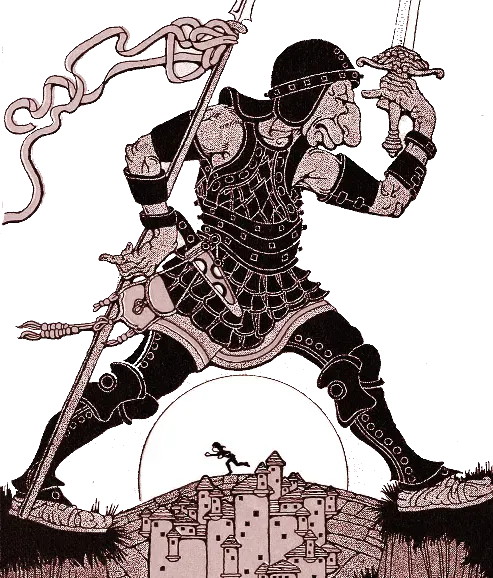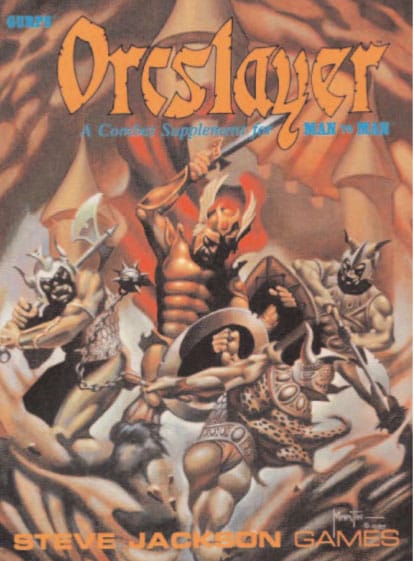
In the last post I wrote about "GURPS 0E", the Man-to-Man combat-centered rules that were released before the complete first box came to market, with the final aim to construct some kind of "old school" rules out of this.
One premise for that was that we're not using anything from later editions. That doesn't leave a lot of room, but we do actually have one supplement for Man to Man: GURPS Orcslayer

Piece by Piece
Orcslayer came out in 1985, just like Man to Man itself. It was written by Steve Jackson, primary author of GURPS, and Warren Spector. Now Mr. Spector isn't an unknown in the game design world these days. He's at least partially responsible for a few legendary video games, including Ultima VI and VII, Wing Commander, System Shock and Thief: The Dark Project.
At the time when Orcslayer came out, he had written the wacky Toon RPG and was the editor of a RPG magazine for Steve Jackson Games.
Orcslayer has 26 pages of adventure, plus helpful material in the appendices.
It describes itself this way:
[Orcslayer] consists of nine linked combat scenarios, separated by "interludes" of travel, rest, and interaction. Each situation is different and will require different tactics.
"Linked combat scenarios" isn't something an OSR fan likes to read. It sounds too much like the modern approach of combat encounters, where everything is pre-set, with a given set of opponents and place where this occurs. The preferred alternative are more organic environments, and ambiguity when it comes to the aggression of the creatures humanoid or not you chance upon.
But Man to Man was written as an example of GURPS combat system, so it wouldn’t make sense to totally avoid that. But interestingly, the “encounters” themselves allow for a good deal of alternative approaches. Anyway, after a short treatise about the setting “Caithness”, we get the following battles, some with pretty decent hex maps to help you in using the Advanced Combat System from Man to Man.
- Midnight Raid – Defend a castle from orcs trying to take yer women (yikes, even for the mid-80s). Has to end up with at least one woman taken, and thus the lord of the castle sending the stalwart band of PCs towards their doom, erm, I mean to Castle Defiant.
- Forest Peril – Cross a forest (and a desert), with the option of helping some elves fighting hobgoblins. Quite a large focus on how travel and survival works.
- The Evil Lizard Kassk – The players can battle a bunch of reptile men interrogating an orc. I've got no idea who Kassk is supposed to be. Later they meet a caravan, get some information and continue.
- Strange Bedfellows – This time there's ten orcs and their leader to fight. This is forced upon the PCs, as there are many such bands marching and they're supposed to find out that their leader is... a dwarf!
- Castle Defiant – Those orcs were marching to besiege said castle, so you have to fight past them and then help out in the siege. If they survived, they learn where the orc HQ is.
- Swamped – But to get to the orcs, they have to pass The Acid Swamps of Solfor! No Rodents of Unusual Size, but a terrible four-armed creature to fight. Guess it's about having non-humanoid opponents for once.
After that, the trek continues through the orc-land. They have to bypass the gate (fighting is possible, but basically no chance), and after that they will encounter an "orc teenager", who promises to lead them straight to the Big Small Boss (the dwarf who took over the orc tribe). - Life is the Pits – Very short encounter, where they discover the entry to the orc caverns, a very small pit, probably to force the PCs to use GURPS' close combat rules. But it's interesting that the opponents have the goal of running away and sounding an alarm, this isn't a fight to the death encounter for them.
- Renegade Dwarf – PCs will have to fight some cannon fodder orc guards, and then end up trying to free all the female prisoners. Bulgan, the dwarf leader is quite something, wielding a hammer that's able to kill most PCs with one hit.
After that, it's a return for the victorious PCs–or not, if the GM decides to extend the campaign.
At the end of the book, you'll find random encounters, character sheets for all the opponents and some helpers, and the new and often used NPC Reaction Table. More about this later.
Read Between the Lines
So much for the general structure, now how does Orcslayer try to add enough to the tactical minigame presented in Man to Man, without going too much for the complete GURPS rules? After all, that’s something I want to achieve later, too.
First of all, it tries very hard to make the IQ stat count. In the main rules, you have to spend a lot of points between your four main stats (ST/strength, DX/dexterity, IQ/intelligence and HT/health). Out of those, ST, DX and HT are obviously important for a fighting character, determining their damage, chance to hit and ability to withstand damage. IQ is used for recovering from surprise, that‘s it.
So in the absence of “mental skills”, the module introduces a lot of times in the “roleplaying” and combat parts where IQ is rolled or used directly (“In Orcslayer, an adventurer will have to make IQ rolls galore”), for example
- “Being sensible”—When the orcs attack and the player of the PC who’s on guard duty fails to sound an alarm, an IQ roll can be used to “correct” the situation. Later only a party where everyone fails their roll will travel through a desert durig the day.
- Perception—noticing a lot of things throughout the adventure, from orc encampments and hidden entries to funny psychedelic mushrooms.
- Finding a way—if they don’t have a guide, they might roll to add an additional day per PC who fails their roll (apparently large parties can be more confused)
- Negotiating—The player of the PC with the highest IQ gets to make the reaction roll for the party (more about that later). By the way, later in the adventure there’s the funny notion that if the group hasn’t name a leader, the “character of the player who talks the most” gets that role…
- Tracking—Following NPCs, and one of the potential allies of the PCs—an elven leader—even gets a +3 to these kind of rolls.
- Background lore—the one weird monster that they encounter in the swamp section has an associated rhyme hinting at its presence and weakness, and you can remember that with an IQ roll.
- Misleading pursuers—here we even get a contest of IQ rolls, i.e. the margins of success are compared if both succeed.
The adventure was written for “up to six” characters, and if you’re close to that, a lot of the times when the whole group can make a roll, success is very likely, never mind that not making it might just cause more search, i.e. repeat rolls. So a classic example of needless rolling.
Skeletons of Society
Another major introduction of Orcslayer is the Reaction Roll mechanic of GURPS. This isn’t too similar from similar mechanics that have existed in D&D since its very beginning. OD&D worked like this:
| 2d6 roll | reaction |
|---|---|
| 2-5 | negative reaction |
| 6-8 | uncertain reaction |
| 9-12 | positive reaction |
Later editions made this more complex, with the BECMI (Red Box etc.) version having multiple stages of reactions, with an initial one and possibilities of improving that through negotiation.
GURPS “0E”’s table itself is quite simple, too
| 3d6 roll | reaction |
|---|---|
| 0 or less | disastrous |
| 1-3 | very bad |
| 4-6 | bad |
| 7-9 | poor |
| 10-12 | neutral |
| 13-15 | good |
| 16-18 | very good |
| 19 or more | excellent |
Each of those results has an explanation what it means for the main categories where reaction rolls are made:
- General reaction
- Potential combat situation
- Requests for aid
- Information requests
This has very good coverage of situation encountered during a roleplaying session, extending beyond the usual “will these goblins attack me” rolls you see elsewhere. And it wouldn’t be GURPS if there weren’t a bunch of modifiers listed, too (from outnumbering your opponents in a potential combat situation to bribes offered during information requests).
With a lack of social skills or GURPS 1E advantages and disadvantages like “Charisma” and “Odious Personal Habits”, nothing on the character sheet influences this, but you’re encouraged to integrate roleplaying. A classic case of the OSR mantra “player skill beats character skill”, isn’t it?
Postmortem
It’s a bit hard to judge this rather peculiar adventure. I think the progression of combat encounters and the opportunities to avoid at least some of them are a good fit for a product that—at its core—has to present Man to Man, i.e. the combat part of GURPS. Because of that premise, looking at it from a modern and/or OSR perspective is a bit unfair.
Things I liked that could also be part of a regular adventure:
- The setting information is minimal, but the “knightly land on the edge of the known world” is a good starting point. There’s a small map, a roster of local leaders, and having to cross both a forest and a desert is believable.
- Along with more stuff to buy than just weapons and armor, there’s a good explanation of how the fatigue rules impact travel. Classic resource-oriented gameplay. Encountering your foe after a solid day’s march can be more dangerous than after a good night’s rest. But you might be discovered during the latter, which is referenced well enough in the text.
- Circumventing combat is often possible. For a combat showcase, this is actually quite daring design, I’ve seen much worse in “proper” roleplaying adventures.
- It’s a deadly game, so finding replacements might be necessary. And Orcslayer mentions where you can find those. Quite often encountering a new “enemy” means that you can then add heroes from that race. And if the initial knightly squires survive, they get some bonus rewards. Adding elves, orcs and even reptile people to a rather white-bread party due to attrition sounds quite fun (and hey, Man to Man is much easier to build characters with than any other version of GURPS)
- The elven leader is described as “Errol Flynn-like” and the illustration even features facial hair like him.
And finally, for using Man to Man as an old-school GURPS system, we did get some missing parts—reaction rolls alone are worth the price of admission, and the aforementioned fatigue rules are very appreciated. I’d give a thumbs down to the usage of IQ rolls, we have to see whether we can do better there.
I’m a bit inspired to mash this up with Keep on the Borderlands, but that has to wait until we’re done with the rules add-ons. Next on my list: Adding the thief and the magic-user niches to a game that has already done more than enough for the fighter.